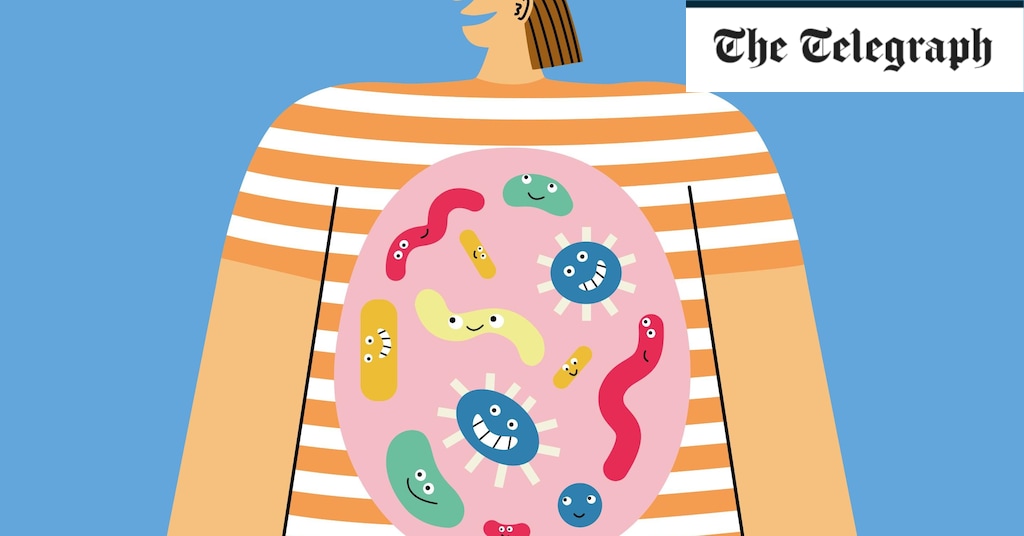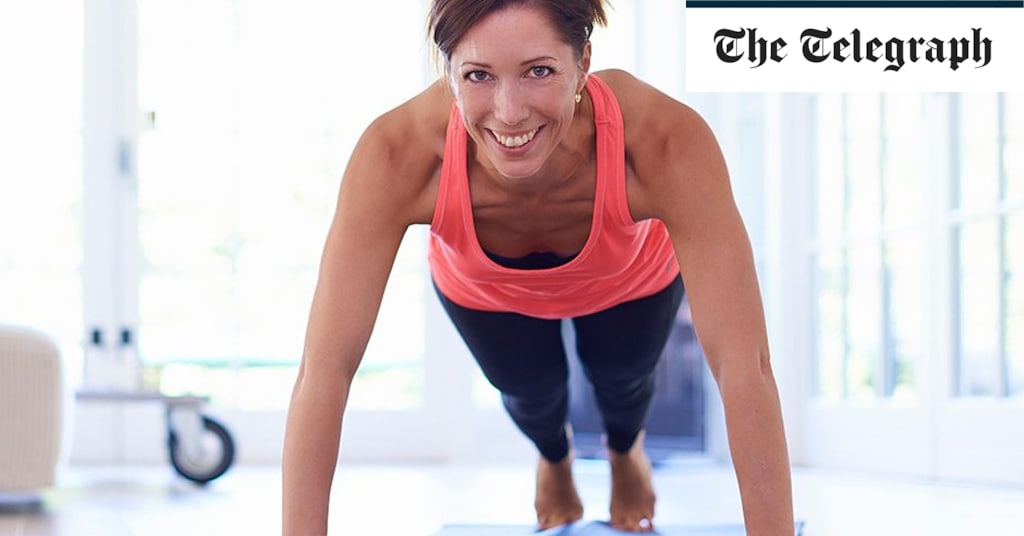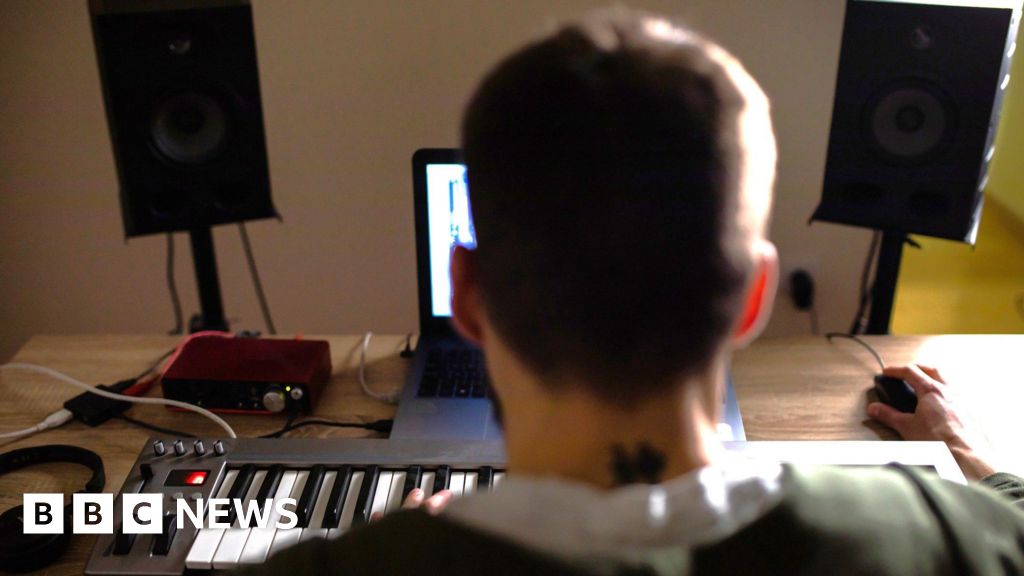Health & fitness
How to feed your gut to lose weight, fight illness and improve health


A diet that lets you eat more
I’m not promoting a fully vegan diet, because research doesn’t necessarily support that from a health perspective. I’m not even suggesting you should go vegetarian. What the evidence suggests is that we could all benefit from eating more plants, but that doesn’t necessarily have to mean only plants.
There is no calorie counting here, no weighing and measuring, and no cutting out. I recommend people aim for 30 – yes, 30 – different plants over the course of a week. It’s much easier than you think if you follow my easy hacks.
Why this target? The five-a-day rule can be a good place to start, but it totally ignores the trillions of microbes living in our gut. They all need different types of plants to flourish.
So when I say eat more, it’s not just about quantity, but also variety.
It’s easy to kid ourselves into thinking we eat a wide variety of foods when really we tend to stick to the same old favourites. It has become cheaper and easier to eat processed foods instead of feeding our gut microbes with the vast array of plants they – and we – need in order to thrive.
While an estimated 300,000 edible plant species are available to humans, more than half of our global energy needs are met by just four: rice, potatoes, wheat and maize.
Many of us just reorder the same supermarket delivery, week in, week out. But our gut microbiota need us to shake it up a bit.
Tea, coffee and even dark chocolate count
The recommended daily intake of fibre is 30 grams in most countries. The average intake? Well under 20 grams. Our ancestors, on the other hand, used to clock up about 100 grams a day!
I’m not suggesting you have to hit that, but increasing your intake by 50 per cent over time is a good place to start. To get 30 grams in a day, around three portions of wholegrains, two pieces of fruit, five portions of veg and one to two portions of nuts, seeds or legumes per day should do it. Upping your fibre by just eight grams per day is linked with a reduced risk of heart disease, type 2 diabetes, colon cancer and death from all causes.
Think ‘plants’ and you might immediately picture green veg and salads. But there’s a wealth of flavour and colour out there to enjoy: wholegrains (barley, oats, millet), fruits, vegetables, nuts and seeds, legumes (beans and pulses), even herbs and spices (including tea and coffee) count. Refined plants such as fruit and vegetable juices and white grains don’t.
What if you’re just not that into plants? There are two things to consider here. First, every food can taste bad if it’s not prepped right. There’s a world of difference between soggy, overcooked broccoli and lightly steamed, crunchy florets roasted in soy sauce and garlic. Second, the way we perceive taste is influenced by a range of factors. Research shows you can train your taste buds by eating more of the foods you don’t (think you) like, particularly for more complex flavours.
Emotional eating? Blame your gut
Forget calories in and out, or restrictive diets that are low fat, low carb and so on. There’s a definite link between our gut and our metabolism. Our gut microbes and the chemicals they make when they digest the fibre we eat from plants can impact appetite. Essentially, they tell our body we’ve had enough. In turn, this halts the production of hunger hormones such as ghrelin, and increases the ‘I’m full’ hormones such as leptin. This likely explains why it’s often fibre intake, independent of calorie intake or type of diet, that results in healthier weight and greater dietary adherence – as shown in the appropriately named 2019 POUNDS study. Other chemicals produced by our microbes are thought to target the reward network part of the brain, which influences our relationship with food and our tendency towards emotional eating.
The gut–metabolism axis doesn’t stop there. Microbes and their metabolites have been linked with ‘turning on’ genes in your body that are related to fat distribution. They can also affect glucose and fat production and storage in the liver.
In a nutshell, feed your GM well and it’s likely to keep everything else in check. So step off the scales, put down the calorie-counting calculator and just eat more plants.
The best foods to boost your resistance to colds, flu and viruses
The following foods are filled with key nutrients and phytochemicals to nourish your immune system:
- Walnut
- Garlic
- Sun-exposed mushrooms (In summer, leave them on the windowsill to absorb sunlight).
- Firm tofu
- Carrots
- Oranges
- Wheat
- Chia seeds
- Turmeric
- Broccoli
“How can I boost my immunity?” is probably one of the top five questions my clients ask. What we don’t hear enough is that immunity is powered by the gut. An impressive 70 per cent of our immune cells actually reside in the gut, alongside our gut microbiota. The microbes teach our immune system what is worth reacting to (like disease-causing microbes) and what is safe (like proteins found in certain foods). So one of the best ways we can support our immunity is by supporting our gut microbiome.
How to get more plants into your diet
- Swap crisps for a handful of toasted nuts or seeds, or try saving your potato or butternut squash peelings to roast in the oven for a crispy snack
- If you’re making a fruit crumble, substitute a third of the flour with oats and another third with ground almonds
- Don’t just add kidney beans to your chilli; replace with mixed beans.
- Switch your single piece of fruit for half a cup of mixed berries (fresh or frozen).
- Every time you go to serve up a meal at home, stop and think, ‘What could I add?’ Chop a banana over your muesli, add some sprouts to your sandwich, slice a tomato on to your plate – every bit counts.
- Stock up on frozen veg and fruit – so when you’ve got nothing fresh left, it doesn’t matter. For extra diversity, buy mixed bags of both.
- No casserole, stew, risotto or pie is complete without one more vegetable than the recipe says – it can be as simple as adding a tin of lentils or chickpeas
- Make up a seed shaker and add a sprinkle to cereals, yoghurt, smoothies and salads, or eggs, avocado on toast, or soup.
Eat More Live Well by Dr Megan Rossi (RRP £16.99). Buy now at books.telegraph.co.uk or call 0844 871 1514
This article has been updated with the latest advice.
Health & fitness
11 reasons why you should stop your fizzy drink habit in 2022


Lead to premature ageing
Phosphates used in fizzy drinks, as well as many other processed foods, have been found to speed up the ageing process.
This is not bad just in terms of potential wrinkles, but also health complications that come with age, such as chronic kidney disease and cardiovascular calcification.
Increased risk of Alzheimer’s
In 2017, scientists in America found that higher consumption of sugar-sweetened beverages was associated with an increased risk of all dementia, AD dementia and stroke.
The Framingham Heart Study, which ran over 20 years, stated that those who had consumed one to seven servings of sugar-sweetened beverages per week were nearly 2 per cent times more likely to develop Alzheimer’s disease than those who consumed none.
Weight gain
This one may seem obvious. However, what you may not know is that diet soft drinks can still affect our waistline dramatically. A 2015 study of 749 adults found that the “waist circumference gain” of people who consumed diet soda on a daily basis was nearly four times greater than non-consumers across a 10-year period.
It concluded that there was a “striking dose-response relationship, increasing diet soda intake was associated with escalating abdominal obesity”.
Increased risk of liver damage
Studies have found that just two cans per day of sugar-sweetened beverages can contribute to the development of non-alcoholic fatty liver disease (NAFLD).
The NHS advises that a healthy liver should contain little to no fat but it is estimated that up to 1 in every 3 people in the UK has early stages of NAFLD, where there are small amounts of fat in their liver.
Cause early puberty
A 2015 Harvard Medical School study of 5,583 girls aged nine to 14 found that those who drank just one-and-a-half cans of soft drink a day had their first periods earlier than those who did not by 2.7 months.
Although the margins seem small, experts argue that women who start their periods younger are at higher risk of future health complications.
Damaging to teeth
Soft drinks can be damaging to teeth – so curbing your fizzy drink habit is the key to keeping your pearly whites healthy. According to Dr Rhona Eskander, Waterpik oral care ambassador and dental professional, recommends drinking unsweetened tea or water instead. “Soft drinks, whether sugar-free or not, contain acid. They can be damaging to teeth and can lead to increased cavities and dental erosion.” She adds that if you must drink soft drinks, try to avoid brushing your teeth immediately after “since acid softens your teeth’s structure, making them more vulnerable to abrasion.”
This article is kept updated with the latest advice.
Health & fitness
Covid v flu v cold and how to tell the difference between symptoms this winter
Can you catch Covid when you have a cold?
According to scientists, not all colds are caused by coronaviruses – so people shouldn’t get complacent and think they are immune to the virus if they’ve recently had a cold.
Dr Simon Clarke, associate professor in cellular microbiology at the University of Reading stated that “it could be a grave mistake to think that anyone who has recently had a cold is protected against Covid-19, as coronaviruses only account for 10-15 per cent of colds.”
How do I know if I have Covid or an allergy?
Having a high temperature (over 38C or 100.4F) is a common sign of a cold or Covid. However, coronavirus can cause loss or change of smell or taste without a blocked nose.
Other allergies can cause a scratchy feeling in your throat. Sore throats are also common in Covid or colds but are more likely to feel painful rather than itchy.
How do I know if my headache is a cold or Covid?
According to Zoe, a Covid headache has particular features that mark it out. They are typically moderate to severe: lasting for three to five days on average and don’t feel better after using painkillers. They are also generally felt on both sides of the head and could feel like they are “pulsing”, “stabbing”, or “pressing”.
Headaches tend to be one of the first signs of Covid but can linger for a while in people with long Covid. Around 15 per cent of people with Covid have a headache as their only symptom.
How do I know if my runny nose is Covid or a cold?
A runny nose can be caused by the common cold or by Covid-19. Getting a runny nose caused by Covid is much more likely when rates of the virus are high in the population at large. When rates are lower, it’s more likely to be caused by other conditions, like an allergy or a cold.
Could my cold be RSV?
It might be, although it’s hard to tell the difference between symptoms. RSV is one of the most common causes of childhood illness, but it can also affect adults. Like the common cold, cases of RSV largely vanished during the lockdowns, but rose steadily afterwards. In adults and healthy children over the age of one, symptoms tend to be mild, and infections usually clear up within a week.
Most babies and young children who catch RSV can be treated at home, in the same way that parents would treat a common cold. The infection usually goes away within two weeks.
More severe cases require a trip to the hospital, where your child might be offered oxygen, IV fluids and medications to open their airways.
What should I do if I don’t know if it’s a cold or Covid?
Unfortunately, despite the “classic” symptoms no longer being the most common, the government is only giving free PCR tests to people with a fever, loss or change in smell or taste or a new, continuous cough.
Experts say that given the changing nature of the illness, people should get a test even if their symptoms are milder or seem more like a cold. “Do stay at home and get a test,” Prof Tim Spector, lead scientist on the Zoe app, said, recommending people who think they may have a cold get a lateral flow test.
“If it’s positive, get a PCR test to make sure, but treat it as if you’ve got Covid,” he said.
How can I tell the difference between earlier strains of Covid and the omicron variant?
The omicron variant has double the mutations of the delta variant and there are now cases of it worldwide.
Key symptoms include fatigue and a high pulse rate but do not include those associated with the earlier strains, such as a fever or loss of taste or smell.
The omicron variant differs to earlier strains and is more easily distinguished against the common cold. Those who contract the common delta variant of Covid tend to display symptoms of coughing, a runny nose, a sore throat and headaches – which are associated with the common cold.
What is the government’s plan for Covid?
As of Thursday 27 January, England’s Plan B measures are no longer in force – including wearing face masks in schools and on public transport.
Boris Johnson made his announcement after addressing the fact that over 90 per cent of over-60s across the UK have now had booster vaccines to protect them, and scientists believed the omicron wave has peaked.
Dr Susan Hopkins, the strategic response director for Covid-19 at Public Health England, warned that hospitals could still become overwhelmed.
Experts from Sage had previously predicted a “pretty miserable” “fourth wave” with infections from other respiratory viruses including bronchiolitis and pneumonia expected to increase among children and the elderly.
This article is regularly updated with the latest advice.
Health & fitness
Anxiety robbed me of my sleep – and by 32, my life was a car crash


The door swings open and a cold beam of artificial light fills my room. Someone with a clipboard says good morning, but it’s impersonal: full of tiredness and boredom. The door shuts and I’m alone again. I turn on a bedside light. It’s seven o’clock but I’ve been awake for hours, woken into a living nightmare.
I’m in London’s oldest private psychiatric hospital, the Priory in Roehampton, having been admitted the previous day as an emergency. During the night, duty nurses have checked on me every hour, making sure I haven’t strung myself up or escaped out of a window, although they’ve given it the gleam of normality by saying it’s ‘for everyone’s safety’ until they know me better.
Even if I wanted to, I couldn’t manage either. It’s as if a bomb has gone off in my head. I feel like a small child again. Even the simplest decisions, such as when to go to breakfast, cause panic. If I go now, will I be early? Or too late? Am I hungry? What should I wear to have breakfast at a psychiatric facility? What if I have to talk to someone?
Thoughts crack like lightning, shifting to my husband and 10-month-old daughter back at home, but I’m too shell-shocked, sleep-deprived and medicated to even cry. The one shining positive that grounds my stomach and drops my shoulders is that, for the first time in weeks, maybe months, I feel safe. The professionals have got their hands on me and I won’t have to cope with my mind on my own any more.
Three years ago – the day before my 32nd birthday – I became one of the 10 per cent of British people who will suffer some kind of disabling anxiety disorder.
Back then, I felt totally at odds with the diagnosis and it’s still something that seems to conflict with so much else about me. I’d amassed, in no particular order, generalised anxiety disorder (GAD), chronic insomnia, a phobia of going to bed (clinophobia) and post-traumatic stress disorder (PTSD).
Stress and anxiety had percolated, fed off each other and imploded in a sort of slow-motion car crash over at least seven years. Depression, unsurprisingly, had recently joined the party. I would have night-time panic attacks as quietly as possible, screaming into a pillow, so as not to wake my husband or baby.
GAD, which affects an estimated one in 15 people, is defined by the NHS as ‘a long-term condition that causes you to feel anxious about a wide range of situations and issues, rather than one specific event’. It’s characterised by at least six months of persistent, excessive and unrealistic worry about everyday things, and is often accompanied by many other non-specific psychological and physical symptoms.
Mine wasn’t linked to postnatal depression, nor could it be neatly packaged as the result of one traumatic experience or moment of abuse. In some ways, at my worst, I believed that would have been easier. At least it would have been understandable, explainable.
Outwardly, it didn’t add up. I was mother to a gregarious, healthy baby who slept and smiled more often than she didn’t. I was married to a brilliant man who has always been a pool of tranquillity, humour and good sense. We lived in a comfortable home in west London. I was close to my family and there were no devastating diagnoses or unmanageable conditions that were pulling us simultaneously apart and together.
I enjoyed life, had a good circle of friends and a decent career as a journalist. Though not a supermodel, I was content with my looks. I liked the clothes I was able to buy and the person inside them.
What happened? It’s a question I’ve returned to frequently but, as hours of group therapy and psycho-education taught me, the key to recovery had nothing to do with solving that question.
Sleepless nights
My sleep issues began in my mid-20s when I was living in London and working for a newspaper. Like almost everyone else I knew, I worked hard and went out frequently.
Life was busy and demanding but enjoyable and gratifying. Yet every few months, two or three nights would pass when I couldn’t fall asleep. It wasn’t that I would wake and not be able to go back to sleep, I would never get there to begin with.
According to the National Institute for Health and Care Excellence (NICE), insomnia is defined as difficulty getting to sleep or maintaining sleep, early waking or non-restorative sleep, that impairs your ability to function and occurs despite opportunity for sleep. Short-term insomnia lasts less than three months, long-term or chronic insomnia lasts longer and commonly co-exists with other psychiatric and medical conditions, such as anxiety and depression.
Normally, most sleep issues clear up on their own, so I kept calm and carried on. During the day, if I felt adrenaline, I pushed it down deep inside my stomach, quashing butterflies that were unhelpful to the job at hand. I moved to another newspaper – this one.
For a time, my sleep levelled, but it slipped after a year or two and I started managing only two to four hours more frequently. Adrenaline, which my body had grown used to producing like a faulty trip switch, was triggered by less and less. I felt it when rushing to nearby Westminster to cover the 2017 terrorist attack (understandable), but also before interviewing the owner of an 80-year-old accordion, or when someone sneezed.
Sometimes it was useful, but often it wasn’t. On the way home after a busy day, I’d be so awash with it that my mind couldn’t be static.
Health & fitness
The secret to a six pack – and how to keep your washboard abs in 2022


You’re not resting in between training
Speaking to Troy, he informs that it is imperative to get good quality sleep each night. “People forget that the body needs this time to recharge, reset and recover – physically and mentally,” says Troy.
He goes on to talk about the importance of rest and training for fit muscles. “Without rest, the muscles don’t have time to recover which can lead to overtraining, fatigue and potential injury.” You can also rest your body through an active recovery such as a long walk or yoga session – as this will stretch out your muscles on your days off.
You’re too stressed
Another scarcely mentioned factor in fat loss is the level of stress you experience on a daily basis. “The more stressed you are the more your body is secreting catabolic hormones like adrenaline and cortisol,” says Scott.
This is a natural process, but the body has evolved to deal with it in an extreme fight or flight scenario. Instead, in today’s office-based world, we get a constant, low level of stress, which means cortisol is gradually released all day long. The result? A lower immune resistance, leaving you vulnerable to colds and flus.
That stressful job or difficult personal relationship could be costing you a lot more than a washboard stomach.
Presentation is key
Scott notes a final reason – that mainly applies to the men in search of a six pack. ‘It took me years to realise that the hard work behind my carefully-honed abs was being undone by my hairy, pale abdomen. Shaving it made a huge difference.”
He adds that if you are looking to have your abs out for a particular event, make sure you avoid heavy foods that could make you bloated. “The wrong meal can completely ruin your aesthetic.”
This article is kept updated with the latest advice and information.
Health & fitness
10 tips for better sleep at night in 2022


It’s never been more crucial to get a good night’s sleep. It’s a new year and, looking at our social calendars, we’re clearly settling into it.
With both physical and mental health on many peoples’ minds more than ever, we have looked at how you can sleep better, including what to do before, during, and after a night’s shuteye.
A lack of sleep or that of poor quality can leave us feeling grumpy and irritable, as well as fatigued. It’s hard to work at your best when tired but sleep deprivation can also have serious effects on your health.
Sleepless nights result in more than just a bad mood, putting you at risk of obesity and other physical health conditions – not to mention increasing anxiety and chances of depression.
According to Cheryl Calverley, CEO at Eve Sleep, sleep is always the answer. “Without good sleep it’s impossible to lose weight or be fitter, improve your mental health and be happier, be a better partner, friend, parent, or son/daughter, be a great leader, manager, team-mate or colleague at work, reach your full potential in whatever it is you want to be and do, or simply live a life as full of happiness as each and every one of us deserve.”
She goes on to say that, frustratingly, many people don’t realise the importance of a good night’s sleep and that prioritising other aspects of wellness ahead of sleep will ultimately not help improve your physical and mental health. “Sleep is where it begins, and ends, and is fundamental to living a healthy and happy life.”
If you’re struggling to sleep, take a look at the tips below for a better night’s rest.
10 tips on how to sleep better
1. Schedule a 30-minute ‘sleep date’
How’s your sleep pattern? On average, UK adults sleep seven and a half hours a night – just hitting the minimum number of recommended hours that we need to function at our best (seven) but still a bit below the higher end of nine hours.
We’re all excellent at making excuses – prioritising everything but our precious shuteye: busy lives, scrolling through social media into the late hours…we are all guilty.
So why not schedule in a “sleep date”? Give your body and mind a reset with this extra segment of sleep – even just an extra 30 minutes could help you catch up and rebalance your body clock.
The idea was suggested by Dr Guy Meadows who co-founded The Sleep School in 2011. He believes a sleep date is a better approach to catching up on lost sleep than having the much-anticipated lie-in on the weekend. “Most of us deprive ourselves of sleep during the week and catch up at the weekend. But a big lie-in makes us feel worse; it gives us jet lag. If you usually get up at 7am and lie in on Saturday until midday, you’re now on New York time.”
Meadows goes on to say “instead, aim to have a midweek catch-up night. Make a thing of it. Put new sheets on the bed, wind down and get the biological sleep you need: seven to eight hours, plus an extra 30 minutes.”
2. Trick your body temperature for a better night’s sleep
We don’t realise how much room temperature can affect our sleep cycle. If the room we’re sleeping in is too hot or too cold, this can mean poor quality of sleep and is often what leads to groggily pressing the snooze button several times over the next morning.
When the body’s core temperature is too warm, it becomes difficult for our brains to make the switch into ‘sleep mode’, and this is often the case on those warm summer nights where you find yourself tossing and turning all evening.
According to experts at the National Sleep Foundation, 18.3 degrees Celsius (65 degrees Fahrenheit) is the optimal room temperature for sleep. It is part of our natural sleep cycle for our bodies to drop two to three degrees in the evening in order to prime our brain and body for a great night’s sleep. This is probably because we have evolved to sleep at night in the open, where the temperature drops naturally.
If you want to hack this process to your own advantage to get a better night’s sleep, try having a bath with the water at approximately 39 degrees Celsius – this will draw the circulating blood to the surface of the skin, allowing your core temperature to drop a few degrees, perfectly replicating your body’s pre-sleep adaptations.
3. Use this breathing trick that sends you to sleep in 60 seconds
No, the answer isn’t holding your breath until you pass out. There really is a breathing technique that could send you skipping towards the land of nod in no time at all.
To master this hack, you need to keep the tip of your tongue behind your upper front teeth at all times, breathe in through your nose for a count of four, hold your breath for a count of seven, then exhale audibly through your mouth for a count of eight. Then repeat between two and four times.
Known as the 4-7-8, this technique was pioneered by US sleep expert Dr Andrew Weil, who says that it helps the lungs to become fully charged with air, allowing more oxygen into the body, and thus promoting a state of calm. “You have to do this two times a day religiously,” he says. “It will become a wonderful way to help you fall asleep. It is utterly simple, takes almost no time, requires no equipment and can be done anywhere.”
Why does it work? Dr Weil calls it “a natural tranquilizer for the nervous system”, which doesn’t tell us a huge amount – but it’s a theme taken up by this MIC article, which explains how any relaxed breathing technique can halt the brain’s stress ‘cascade’, by calming the hypothalamus, pituitary and adrenal glands.
Repeat the process daily for a few weeks and your brain will learn to treat it as a signal that it’s safe to shut down for a while.
4. Turn off artificial light to avoid weight gain
Did you know that falling asleep in front of the TV can affect your weight? Or that sleeping with a night light on can (gradually) pile on the pounds?
Research from 2019 by the National Institute of Environmental Health Science in the US showed that women who slept with a night light or the TV on were 17 per cent more likely to gain 5kg or more over the next five years.
They were also 22 per cent more likely to become newly overweight and 33 per cent more like to become newly obese.
The study followed 43,772 women aged 35-74 over five years. Participants shared information about their weight, BMI and how much artificial light they were exposed to at night.
According to Professor Malcolm von Schantz from the University of Surrey, “The findings make perfect biological sense… Light at night affects our metabolism.”
Artificial light is known to disrupt the production of melatonin, the hormone which the body uses to regulate feelings of sleepiness. Less melatonin equals less deep sleep which means less efficient digestion.
5. Stop ‘snoozing’
Health & fitness
a guide to midlife strength training


‘Dad strength’ (or mum strength) is one of the perks of ageing: strength takes a long time to build and almost as long to lose, meaning that a lifetime of moderately challenging physical tasks can see most people keep their strength well into middle age.
But, if that is the case, what is the point of strength training? Well, a study conducted by researchers at Iowa State University in June 2021 found that although it was once seen as an optional extra, strength training should be considered at least as important as aerobic exercise.
The research went on to show that two or more sessions of weight-training a week was enough to reduce the risk of obesity by 20 to 30 per cent over two decades, even for people who do no aerobic exercise.
The good news? Strength training doesn’t need to be complex, difficult, or even sweaty: and it definitely doesn’t require a Lycra-clad coach yelling at you. The keys to an effective strength training plan are rest and progression.
The first one is good news: working out for strength means doing challenging movements with relatively long rests in between, allowing you to fully recover between efforts. It also means there’s no need to train every day.
As for ‘progression’, this just means you need a way to make the exercises harder. For most movements, you’re still building strength when the most reps you can manage in a single set stays in the 3-12 range: much over that, and you’ve moved over to muscular endurance.
Finally, you need to make sure you’re hitting every bit of your body if possible by making sure you push, pull, squat, and load-carry (carrying heavy shopping, for example). In an ideal world you’d also add a hip-hinge (the thing you do when you swing a kettlebell or deadlift anything off the ground), but that’s a bit more fraught, so focus on the basics to start with.
Whether you’re going to try these exercises out at the gym or incorporate them into your home workouts, these routines are sure to give your muscles a work-out.
There are two options, A and B, which you should aim to alternate: either do both in the same week, or do ABA one week and BAB the next, taking at least one rest day between sessions. Start with the simplest variation of each movement that you can manage: once you can hit the top of the recommended rep range, switch to a more difficult one in your next workout.
Workout A
1. Push (horizontal): 5-10 reps, 3 sets
Easy: Wall press-up
Medium: Incline press-up
Hard: Press-up
2. Pull: 5-10 reps, 3 sets
Bent-over row with weights, cans or 2-litre milk jugs.
3. Squat (two-legged): 8-12 reps, 4 sets
Easy: Doorway squat
Medium: Bodyweight squat
Hard: Rucksack squat
4. Carry: 20 minutes, 2 sets
Workout B
1. Push (vertical): 5-10 reps, 3 sets
Easy: Wall angel
Medium/Hard: Overhead press with cans, milk jugs, dumbbells or a rucksack
2. Curl: 5-10 reps, 3 sets
Biceps curls with cans, bands or a rucksack.
3. One-legged squat variation: 8-12 reps, 4 sets
Easy: Split squat
Medium: Lunge
Hard: Rucksack lunge
4. Carry: 10m each side, 2 sets
Don’t push any of this, and consult a professional in advance if you have any doubts about your ability to manage any of these movements. You should rest for 1-2 minutes after every set, and stop every set well short of ‘failure’ – if you find yourself grinding out slower and slower reps, stop rather than push through.
What to eat to gain better strength
-

 Sport7 hours ago
Sport7 hours agoJoshua vs Dubois: Chris Eubank Jr says ‘AJ’ could beat Tyson Fury and any other heavyweight in the world
-

 News1 day ago
News1 day agoYou’re a Hypocrite, And So Am I
-

 Technology6 hours ago
Technology6 hours agoiPhone 15 Pro Max Camera Review: Depth and Reach
-

 CryptoCurrency7 hours ago
CryptoCurrency7 hours agoDecentraland X account hacked, phishing scam targets MANA airdrop
-

 CryptoCurrency7 hours ago
CryptoCurrency7 hours agoBitcoin miners steamrolled after electricity thefts, exchange ‘closure’ scam: Asia Express
-

 CryptoCurrency7 hours ago
CryptoCurrency7 hours agoSEC asks court for four months to produce documents for Coinbase
-

 News8 hours ago
News8 hours agoIsrael strikes Lebanese targets as Hizbollah chief warns of ‘red lines’ crossed
-

 Sport7 hours ago
Sport7 hours agoUFC Edmonton fight card revealed, including Brandon Moreno vs. Amir Albazi headliner
-

 CryptoCurrency6 hours ago
CryptoCurrency6 hours agoEthereum is a 'contrarian bet' into 2025, says Bitwise exec
-

 Science & Environment10 hours ago
Science & Environment10 hours agoHow one theory ties together everything we know about the universe
-

 CryptoCurrency7 hours ago
CryptoCurrency7 hours agoSEC settles with Rari Capital over DeFi pools, unregistered broker activity
-

 News5 hours ago
News5 hours agoBrian Tyree Henry on voicing young Megatron, his love for villain roles
-

 Science & Environment21 hours ago
Science & Environment21 hours agoQuantum time travel: The experiment to ‘send a particle into the past’
-

 Science & Environment7 hours ago
Science & Environment7 hours agoWe may have spotted a parallel universe going backwards in time
-

 CryptoCurrency7 hours ago
CryptoCurrency7 hours ago2 auditors miss $27M Penpie flaw, Pythia’s ‘claim rewards’ bug: Crypto-Sec
-

 CryptoCurrency7 hours ago
CryptoCurrency7 hours agoArthur Hayes’ ‘sub $50K’ Bitcoin call, Mt. Gox CEO’s new exchange, and more: Hodler’s Digest, Sept. 1 – 7
-

 CryptoCurrency7 hours ago
CryptoCurrency7 hours agoTreason in Taiwan paid in Tether, East’s crypto exchange resurgence: Asia Express
-

 CryptoCurrency7 hours ago
CryptoCurrency7 hours agoLeaked Chainalysis video suggests Monero transactions may be traceable
-

 CryptoCurrency7 hours ago
CryptoCurrency7 hours agoJourneys: Robby Yung on Animoca’s Web3 investments, TON and the Mocaverse
-

 CryptoCurrency7 hours ago
CryptoCurrency7 hours agoLouisiana takes first crypto payment over Bitcoin Lightning
-

 CryptoCurrency7 hours ago
CryptoCurrency7 hours agoAre there ‘too many’ blockchains for gaming? Sui’s randomness feature: Web3 Gamer
-

 CryptoCurrency7 hours ago
CryptoCurrency7 hours agoCrypto whales like Humpy are gaming DAO votes — but there are solutions
-

 CryptoCurrency7 hours ago
CryptoCurrency7 hours agoHelp! My parents are addicted to Pi Network crypto tapper
-

 CryptoCurrency7 hours ago
CryptoCurrency7 hours agoFive crypto market predictions that haven’t come true — yet
-

 CryptoCurrency7 hours ago
CryptoCurrency7 hours ago$12.1M fraud suspect with ‘new face’ arrested, crypto scam boiler rooms busted: Asia Express
-

 CryptoCurrency7 hours ago
CryptoCurrency7 hours ago‘Everything feels like it’s going to shit’: Peter McCormack reveals new podcast
-

 CryptoCurrency7 hours ago
CryptoCurrency7 hours agoSEC sues ‘fake’ crypto exchanges in first action on pig butchering scams
-

 CryptoCurrency7 hours ago
CryptoCurrency7 hours agoFed rate cut may be politically motivated, will increase inflation: Arthur Hayes
-

 CryptoCurrency7 hours ago
CryptoCurrency7 hours agoBinance CEO says task force is working ‘across the clock’ to free exec in Nigeria
-

 CryptoCurrency7 hours ago
CryptoCurrency7 hours agoBitcoin price hits $62.6K as Fed 'crisis' move sparks US stocks warning
-

 CryptoCurrency7 hours ago
CryptoCurrency7 hours agoCZ and Binance face new lawsuit, RFK Jr suspends campaign, and more: Hodler’s Digest Aug. 18 – 24
-

 CryptoCurrency7 hours ago
CryptoCurrency7 hours agoCardano founder to meet Argentina president Javier Milei
-

 CryptoCurrency7 hours ago
CryptoCurrency7 hours agoCertiK Ventures discloses $45M investment plan to boost Web3
-

 CryptoCurrency7 hours ago
CryptoCurrency7 hours agoMemecoins not the ‘right move’ for celebs, but DApps might be — Skale Labs CMO
-

 CryptoCurrency7 hours ago
CryptoCurrency7 hours agoBitcoin bull rally far from over, MetaMask partners with Mastercard, and more: Hodler’s Digest Aug 11 – 17
-

 CryptoCurrency7 hours ago
CryptoCurrency7 hours agoDorsey’s ‘marketplace of algorithms’ could fix social media… so why hasn’t it?
-

 CryptoCurrency7 hours ago
CryptoCurrency7 hours agoTelegram bot Banana Gun’s users drained of over $1.9M
-

 CryptoCurrency7 hours ago
CryptoCurrency7 hours agoLow users, sex predators kill Korean metaverses, 3AC sues Terra: Asia Express
-

 CryptoCurrency7 hours ago
CryptoCurrency7 hours agoBlockdaemon mulls 2026 IPO: Report
-

 News5 hours ago
News5 hours ago“Beast Games” contestants sue MrBeast’s production company over “chronic mistreatment”
-

 Technology3 days ago
Technology3 days agoYouTube restricts teenager access to fitness videos
-

 Science & Environment10 hours ago
Science & Environment10 hours ago‘Running of the bulls’ festival crowds move like charged particles
-

 Politics21 hours ago
Politics21 hours agoWhat is the House of Lords, how does it work and how is it changing?
-

 MMA7 hours ago
MMA7 hours agoUFC’s Cory Sandhagen says Deiveson Figueiredo turned down fight offer
-

 MMA7 hours ago
MMA7 hours agoDiego Lopes declines Movsar Evloev’s request to step in at UFC 307
-

 Football6 hours ago
Football6 hours agoNiamh Charles: Chelsea defender has successful shoulder surgery
-

 Football6 hours ago
Football6 hours agoSlot's midfield tweak key to Liverpool victory in Milan
-

 Fashion Models6 hours ago
Fashion Models6 hours agoMiranda Kerr nude
-

 Politics6 hours ago
Politics6 hours agoLabour MP urges UK government to nationalise Grangemouth refinery
-

 Science & Environment10 hours ago
Science & Environment10 hours agoRethinking space and time could let us do away with dark matter
-

 Entertainment5 hours ago
Entertainment5 hours ago“Jimmy Carter 100” concert celebrates former president’s 100th birthday
-

 Science & Environment18 hours ago
Science & Environment18 hours agoSunlight-trapping device can generate temperatures over 1000°C
-

 News5 hours ago
News5 hours agoJoe Posnanski revisits iconic football moments in new book, “Why We Love Football”
-

 Health & fitness2 days ago
Health & fitness2 days agoWhen Britons need GoFundMe to pay for surgery, it’s clear the NHS backlog is a political time bomb
-

 Science & Environment20 hours ago
Science & Environment20 hours agoQuantum to cosmos: Why scale is vital to our understanding of reality
-

 Technology3 days ago
Technology3 days agoTrump says Musk could head ‘government efficiency’ force
-

 Science & Environment18 hours ago
Science & Environment18 hours agoDoughnut-shaped swirls of laser light can be used to transmit images
-

 Science & Environment16 hours ago
Science & Environment16 hours agoBlack holes scramble information – but may not be the best at it
-

 Science & Environment16 hours ago
Science & Environment16 hours agoThe galactic anomalies hinting dark matter is weirder than we thought
-

 CryptoCurrency7 hours ago
CryptoCurrency7 hours agoTelegram CEO cannot leave France, OpenSea receives Wells notice, and more: Hodler’s Digest, Aug. 25 – 31
-

 CryptoCurrency7 hours ago
CryptoCurrency7 hours agoSolana unveils new Seeker device, says it’s not just a ‘memecoin phone’
-

 CryptoCurrency7 hours ago
CryptoCurrency7 hours agoCrypto scammers orchestrate massive hack on X but barely made $8K
-

 CryptoCurrency7 hours ago
CryptoCurrency7 hours agoBitcoiners are ‘all in’ on Trump since Bitcoin ’24, but it’s getting risky
-

 CryptoCurrency7 hours ago
CryptoCurrency7 hours agoReal-world asset tokenization is the crypto killer app — Polygon exec
-

 Science & Environment10 hours ago
Science & Environment10 hours agoJupiter’s stormy surface replicated in lab
-

 Science & Environment10 hours ago
Science & Environment10 hours agoFuture of fusion: How the UK’s JET reactor paved the way for ITER
-
Politics10 hours ago
Owen Paterson loses ECHR appeal against report that preceded downfall | Owen Paterson
-

 CryptoCurrency7 hours ago
CryptoCurrency7 hours agoDuckDuckGo ranks Etherscan phishing websites in top results
-

 CryptoCurrency7 hours ago
CryptoCurrency7 hours agoVonMises bought 60 CryptoPunks in a month before the price spiked: NFT Collector
-

 CryptoCurrency7 hours ago
CryptoCurrency7 hours agoVitalik tells Ethereum L2s ‘Stage 1 or GTFO’ — Who makes the cut?
-

 CryptoCurrency7 hours ago
CryptoCurrency7 hours agoEthereum falls to new 42-month low vs. Bitcoin — Bottom or more pain ahead?
-
Business7 hours ago
Thames Water seeks extension on debt terms to avoid renationalisation
-
Business6 hours ago
How Labour donor’s largesse tarnished government’s squeaky clean image
-
Business5 hours ago
UK hospitals with potentially dangerous concrete to be redeveloped
-
Business5 hours ago
Axel Springer top team close to making eight times their money in KKR deal
-

 News5 hours ago
News5 hours agoSean “Diddy” Combs denied bail again in federal sex trafficking case
-

 News5 hours ago
News5 hours agoSean “Diddy” Combs denied bail again in federal sex trafficking case in New York
-

 News5 hours ago
News5 hours agoBrian Tyree Henry on his love for playing villains ahead of “Transformers One” release
-

 News5 hours ago
News5 hours agoBrian Tyree Henry on voicing young Megatron, his love for villain roles
-

 News9 hours ago
News9 hours agoPolice chief says Daniel Greenwood 'used rank to pursue junior officer'
-

 News9 hours ago
News9 hours agoChurch same-sex split affecting bishop appointments
-

 Technology2 days ago
Technology2 days agoIs carbon capture an efficient way to tackle CO2?
-

 Politics2 days ago
Politics2 days agoTrump says he will meet with Indian Prime Minister Narendra Modi next week
-

 Science & Environment10 hours ago
Science & Environment10 hours agoPhysicists have worked out how to melt any material
-

 Politics22 hours ago
Politics22 hours agoKeir Starmer facing flashpoints with the trade unions
-

 CryptoCurrency2 days ago
CryptoCurrency2 days agoBitcoin reclaims $60K and ‘this time is different,’ says analyst
-

 Health & fitness2 days ago
Health & fitness2 days agoWhy you should take a cheat day from your diet, and how many calories to eat
-

 Technology8 hours ago
Technology8 hours agoFivetran targets data security by adding Hybrid Deployment
-
News2 days ago
Why is XRP price up today?
-

 Science & Environment1 day ago
Science & Environment1 day agoElon Musk’s SpaceX contracted to destroy retired space station
-

 Science & Environment2 days ago
Science & Environment2 days agoOur reality seems to be compatible with a quantum multiverse
-
News7 hours ago
Freed Between the Lines: Banned Books Week
-

 Technology3 days ago
Technology3 days agoMusician charged with using bots to boost streaming revenue
-

 Technology2 days ago
Technology2 days agoNYC using drones to warn residents of floods
-

 Sport7 hours ago
Sport7 hours agoUFC’s Dan Ige feels confident after Diego Lopes dominates Brian Ortega
-
Business2 days ago
Music mogul Sean Combs charged with racketeering and sex trafficking
-

 MMA7 hours ago
MMA7 hours agoConor McGregor denies allegation he sexually assaulted woman at NBA Finals
-

 News2 days ago
News2 days agoStory Behind Ryan Murphy’s FX Show About Aaron Hernandez
-

 Science & Environment10 hours ago
Science & Environment10 hours agoThe physicist searching for quantum gravity in gravitational rainbows
-

 Technology1 day ago
Technology1 day agoTech Life: The tech that refuses to die

You must be logged in to post a comment Login